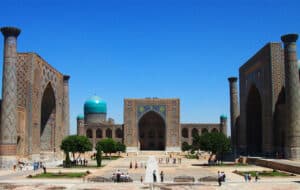Table Of Contents
Rukhabad Mausoleum
1. Introduction
The Rukhabad Mausoleum (sometimes spelled “Rukhobod” or “Rukhbad”) is a modest yet historically significant monument located in the heart of Samarkand. Built in the late 14th century under the patronage of Timur (Tamerlane), the mausoleum enshrines the remains of a revered Sufi mystic, and, according to local lore, may also hold sacred relics. While less grand than other Timurid landmarks like Gur-e-Amir or the Registan Ensemble, Rukhabad’s spiritual importance and austere elegance offer a unique window into Samarkand’s religious and cultural heritage.
Local Tradition:
Some accounts suggest that a casket at Rukhabad may contain a lock of the Prophet Muhammad’s hair, contributing to the mausoleum’s enduring reverence as a holy site.
2. Historical Background
Commissioning by Timur
- Personal Devotion: Timur built the mausoleum in honor of the mystic Sheikh Burhan ad-Din Sagarji (commonly associated with Rukhabad), whom he greatly respected.
- Spiritual Anchor: In a city renowned for majestic madrasahs and mosques, Rukhabad served as a more intimate place of worship and reflection, aligning with Timur’s practice of honoring spiritual figures.
Significance in Timurid Samarkand
- Sufi Influence: Sufism played a major role in the cultural and religious life of Central Asia. Rukhabad’s revered occupant attracted pilgrims and scholars, further enhancing Samarkand’s status as an intellectual and spiritual center.
- Complement to Larger Monuments: When viewed alongside nearby monuments (e.g., Gur-e-Amir), Rukhabad highlights how the Timurid dynasty patronized both grand and humble religious structures to express devotion and piety.
3. Architecture & Design
Simplicity & Harmony
- Modest Dome: Rukhabad’s single, unadorned dome contrasts sharply with the lavish tilework of other Timurid buildings. The subdued exterior design underscores the Sufi ideals of humility and introspection.
- Rectangular Layout: The mausoleum’s rectangular base supports the dome, and smaller arches and entrances provide a balanced, symmetrical appearance typical of Timurid architecture, albeit on a simpler scale.
Interior Highlights
- Central Tomb Chamber: The mausoleum’s focal point is a plain tomb structure where Sheikh Burhan ad-Din Sagarji is interred. Reverent visitors sometimes leave offerings or recite prayers.
- Minimal Ornamentation: Where many local monuments dazzle with colored tiles, Rukhabad’s interior is mostly plain brick and plaster. This austere approach may have been intentional, reflecting a deeply spiritual atmosphere.
Symbolic Elements
- Spiritual Reliquary: Local belief holds that sacred relics, such as the Prophet’s hair or other items belonging to the saint, were placed in a hidden chamber—lending a special reverential quality to the space.
- Placement in Samarkand: Built at a prominent crossroads near other significant structures, Rukhabad served as a constant reminder of the spiritual dimension within a vibrant, cosmopolitan city.
4. Planning Your Visit
Location & Accessibility
- Proximity to Main Sites: Rukhabad is located near the Gur-e-Amir Mausoleum and within walking distance of other major attractions like Registan Square.
- Transport Options:
- Taxi: A quick ride from most central Samarkand hotels.
- On Foot: Many visitors explore Samarkand’s historical core by strolling between monuments, which is feasible and atmospheric.
Ticket & Opening Hours
- Entrance Fees: Rukhabad is often free or nominal to enter. Some visitors simply give a small donation if they wish. (Policies can change, so confirm on arrival.)
- Operating Times: Generally open throughout the day, though exact hours may vary. If locked, you can sometimes ask local attendants or caretakers for a brief interior viewing.
Etiquette
- Respectful Dress & Conduct: Given its reputation as a holy site, dress modestly (cover shoulders, avoid shorts) and keep voices low inside the chamber.
- Photography: Often allowed, but avoid flash indoors and respect any areas marked off-limits. If locals are present in prayer, seek permission before taking photos in their vicinity.
5. Cultural & Religious Significance
- Sufi Heritage: Rukhabad’s occupant was linked to Sufism, a mystical branch of Islam emphasizing inner devotion. Pilgrims may visit to receive blessings or spiritual inspiration.
- Role in Local Identity: For many Samarkandis, Rukhabad symbolizes continuity—a place where centuries-old traditions remain alive, tying modern life to the city’s historic religious fabric.
- Community Ties: The mausoleum occasionally hosts small gatherings for recitations or communal prayers, reflecting everyday faith beyond tourist interest.
6. Photography Tips
While Rukhabad may not boast lavish tilework, it offers unique photographic opportunities:
- Play with Light & Shadow
- The dome’s interior can reveal subtle patterns of light through small windows or openings.
- Sunrise or late-afternoon rays often cast evocative shadows on the mausoleum’s exterior.
- Focus on Architectural Contrast
- Capture juxtaposition shots: photograph Rukhabad in the foreground against a distant, more ornate structure like Gur-e-Amir, highlighting the stark difference in design.
- Detail Shots
- The brickwork and arches can showcase delicate craftsmanship. Zoom in on bricks, mortar lines, or subtle inscriptions.
- Respectful Candids
- If you observe local pilgrims, you might capture discreet, respectful images of the mausoleum in use, showcasing its living religious context.
7. Nearby Attractions
- Gur-e-Amir Mausoleum: Resting place of Timur and his descendants, famous for its azure dome and lavish interior.
- Registan Ensemble: Samarkand’s architectural masterpiece featuring three grand madrasahs (Ulugh Beg, Sher-Dor, Tilya-Kori).
- Bibi-Khanym Mosque: A Timurid-era mosque known for its once-towering dome and proximity to Siab Bazaar.
- Shah-i-Zinda Necropolis: An avenue of mausoleums boasting some of Central Asia’s most intricate tilework.
8. Practical Tips & Safety
- Weather & Comfort: Samarkand can get very hot in summer—carry water and wear sun protection. Winters are chilly but less crowded.
- Local Guides: A short guided explanation can enrich your visit, revealing the context of Rukhabad’s spiritual significance and linking it to broader Timurid history.
- Personal Belongings: Petty theft is uncommon but can occur in busy areas, so keep valuables secure.
9. Conclusion
Although modest in scale, the Rukhabad Mausoleum holds deep cultural and religious importance within Samarkand’s tapestry of Timurid landmarks. Its simple lines and serene atmosphere reflect the mystical devotion that shaped much of Central Asia’s spiritual life. Whether you’re a history buff, a cultural explorer, or a traveler drawn to less-crowded historical gems, Rukhabad invites you to pause and reflect. In the shadow of grand mosques and monumental madrasahs, this humble mausoleum quietly stands as a spiritual beacon bridging Samarkand’s past and present.
Final Thought:
“In the city of gleaming domes, it is sometimes the simplest shrine that holds the most profound sense of peace.”
Set aside some time to step within Rukhabad’s walls, absorb its tranquil air, and connect with the subtle pulse of Sufi tradition that still resonates in modern-day Samarkand.
Related Tours




